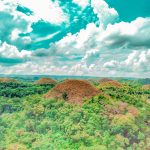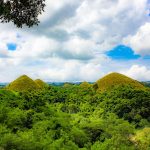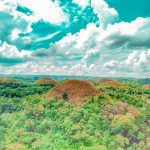Download links
How to install The Mysterious Chocolate Hills: A Natural Wonder APK?
1. Tap the downloaded The Mysterious Chocolate Hills: A Natural Wonder APK file.
2. Touch install.
3. Follow the steps on the screen.
Description
Nestled in the heart of Bohol, Philippines, the Chocolate Hills stand as one of the most iconic natural wonders of the world. This unique geological formation consists of over 1,200 symmetrical hills that rise dramatically from the surrounding landscape, creating a breathtaking panorama that captivates visitors and locals alike. The hills are particularly famous for their striking appearance during the dry season when the grass covering them turns a rich brown hue, resembling mounds of chocolate—hence their name.
This enchanting sight has made the Chocolate Hills a popular destination for tourists seeking both adventure and tranquility in nature. The allure of the Chocolate Hills extends beyond their visual appeal; they are steeped in local history and culture, making them a significant landmark for the people of Bohol. The hills have become a symbol of the region, representing not only its natural beauty but also its rich cultural heritage.
As visitors flock to this UNESCO World Heritage Site, they are drawn not only by the stunning vistas but also by the stories and legends that surround these geological marvels. The Chocolate Hills are more than just a tourist attraction; they embody the spirit of Bohol and its people, offering a glimpse into the natural wonders that define this beautiful archipelago.
Key Takeaways
- The Chocolate Hills are a unique geological formation located in the Bohol province of the Philippines, consisting of over 1,200 cone-shaped hills.
- The formation of the Chocolate Hills is believed to be the result of limestone weathering and erosion over millions of years, creating their distinct shape and color.
- The Chocolate Hills are home to a diverse range of flora and fauna, including various species of plants, birds, and mammals, making it an important ecological site.
- The Chocolate Hills hold cultural and folklore significance for the local community, with legends attributing their formation to the tears of a giant who fell in love with a mortal woman.
- Conservation efforts and sustainable tourism initiatives are being implemented to preserve the natural beauty and ecological integrity of the Chocolate Hills for future generations.
Formation and Geology of the Chocolate Hills
The formation of the Chocolate Hills is a fascinating tale of geological processes that span millions of years. These hills are primarily composed of limestone, which was formed from the remains of marine organisms that settled on the ocean floor during the Pleistocene epoch. Over time, tectonic activity caused the land to rise, exposing these limestone deposits to erosion.
The unique conical shapes of the hills were sculpted by a combination of weathering and erosion processes, including rainwater runoff and the action of wind. This intricate interplay between geological forces has resulted in the distinct topography that characterizes the region today. The Chocolate Hills are not only remarkable for their shape but also for their uniformity in size and structure.
Most of the hills range from 30 to 50 meters in height, with some reaching up to 120 meters. Their symmetrical forms are a testament to the consistent geological processes that shaped them. The region’s karst topography is also noteworthy; it features underground rivers and caves formed by the dissolution of limestone, further contributing to the area’s unique landscape.
Flora and Fauna of the Chocolate Hills

The ecological diversity surrounding the Chocolate Hills is as captivating as their geological features. The area is home to a variety of plant species, many of which thrive in the region’s tropical climate. The hills are primarily covered with grass, which turns brown during the dry season, but they also support a range of other vegetation, including shrubs and trees that provide habitat for various wildlife species.
The lush greenery that flourishes during the rainy season creates a stark contrast to the arid landscape that emerges later in the year, showcasing nature’s resilience and adaptability. In terms of fauna, the Chocolate Hills are inhabited by numerous species, some of which are endemic to Bohol. Birds such as the Philippine tarsier, one of the world’s smallest primates, can be found in this region, along with various reptiles and insects that contribute to the area’s biodiversity.
The presence of these species highlights the ecological significance of the Chocolate Hills as a habitat for wildlife. Conservation efforts are crucial to maintaining this delicate ecosystem, ensuring that both flora and fauna continue to thrive amidst increasing human activity and environmental changes.
Cultural and Folklore Significance of the Chocolate Hills
| Aspect | Details |
|---|---|
| Number of Hills | There are estimated to be around 1,268 individual hills in the Chocolate Hills area. |
| Legend | According to local folklore, the Chocolate Hills were formed from the tears of a giant named Arogo who wept over the death of his beloved. |
| Cultural Importance | The Chocolate Hills are considered a national geological monument and are a popular symbol of the Philippines. |
| Local Festivals | The Chocolate Hills are celebrated in the annual Bohol Chocolate Hills Festival, which includes cultural performances and competitions. |
| Mythical Creatures | Local folklore also includes stories of mythical creatures living in the hills, adding to their cultural significance. |
The Chocolate Hills hold a special place in local folklore and cultural narratives, enriching their significance beyond mere geological interest. One popular legend tells the story of two giants who engaged in a fierce battle, hurling boulders at each other until they grew tired and decided to bury their weapons beneath the earth. The remnants of their conflict supposedly transformed into the hills we see today.
This tale not only adds a layer of mystique to the landscape but also reflects the rich oral traditions that permeate Filipino culture. Moreover, the Chocolate Hills have become an integral part of Bohol’s identity, often featured in local art, literature, and festivals. They symbolize resilience and beauty in nature, serving as a source of inspiration for artists and writers alike.
The hills are frequently depicted in paintings and crafts sold by local artisans, showcasing their importance as a cultural icon. Additionally, various festivals celebrate Bohol’s natural wonders, with events often highlighting the Chocolate Hills as a central theme. This cultural significance reinforces the connection between the people of Bohol and their environment, fostering a sense of pride and stewardship over this remarkable landscape.
Conservation Efforts and Tourism in the Chocolate Hills
As tourism continues to grow in popularity around the Chocolate Hills, conservation efforts have become increasingly vital to protect this unique ecosystem from potential degradation. Local government initiatives have been established to promote sustainable tourism practices that minimize environmental impact while allowing visitors to appreciate the natural beauty of the area. These efforts include establishing designated viewing areas, implementing waste management systems, and educating tourists about responsible behavior while exploring this fragile environment.
The balance between tourism and conservation is delicate; while visitors contribute significantly to the local economy, their presence can also pose threats to the ecosystem if not managed properly. Community involvement is crucial in these conservation efforts, as local residents play an essential role in safeguarding their natural heritage. By engaging with local communities and providing them with opportunities for sustainable livelihoods through eco-tourism initiatives, stakeholders can foster a sense of ownership and responsibility towards preserving the Chocolate Hills for future generations.
The Future of the Chocolate Hills: Threats and Preservation

Threats from Human Activity
In addition to climate change, increased tourism and urban development pressures also threaten the Chocolate Hills. If not managed sustainably, tourism can lead to habitat destruction, while urban development can encroach upon this natural wonder as Bohol continues to grow economically.
The Need for Collective Action
To ensure the preservation of the Chocolate Hills for future generations, it is essential to implement comprehensive strategies to address these challenges. This includes enhancing environmental education programs aimed at both locals and tourists to foster greater awareness about conservation issues. Collaboration between government agencies, non-governmental organizations, and local communities is crucial in developing effective policies that prioritize ecological integrity while promoting sustainable tourism practices.
A Call to Action
In conclusion, the future of the Chocolate Hills hinges on our collective commitment to preserving this unique landscape amidst growing pressures from climate change and human activity. By embracing sustainable practices and fostering a deep respect for this natural wonder, we can ensure that generations to come will continue to marvel at its beauty and significance.
If you’re interested in exploring more unique natural wonders like the Chocolate Hills, you may want to check out this article on unusual travel destinations. This article highlights some lesser-known places around the world that are worth adding to your travel bucket list. Who knows, you may discover your next favorite vacation spot!
FAQs
What are the Chocolate Hills?
The Chocolate Hills are a geological formation located in the Bohol province of the Philippines. They are made up of around 1,200 to 1,776 conical limestone hills, which are covered in green grass that turns brown during the dry season, giving them a chocolate-like appearance.
How were the Chocolate Hills formed?
The exact formation process of the Chocolate Hills is still a subject of debate among geologists. However, it is widely believed that they were formed by the uplift of coral deposits and the action of rainwater and erosion over millions of years.
What is the significance of the Chocolate Hills?
The Chocolate Hills are a major tourist attraction in the Philippines and are considered a natural wonder. They are also a candidate for inclusion in the UNESCO World Heritage List.
Can visitors explore the Chocolate Hills?
Yes, visitors can explore the Chocolate Hills by climbing to the top of some of the hills, where they can enjoy panoramic views of the surrounding countryside. There are also viewing decks and platforms for visitors to take in the beauty of the hills.
Are there any legends or myths associated with the Chocolate Hills?
One popular legend about the formation of the Chocolate Hills involves two giants who engaged in a battle, throwing rocks and sand at each other for days. When they finally made amends, they left behind the mess they created, which became the Chocolate Hills.





